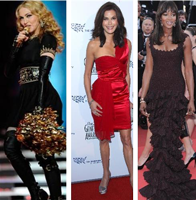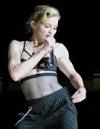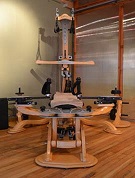About GYROTONIC® exercise
The GYROTONIC® method is a holistic system of movements that
gives strength and flexibility, and a great deal more. Our lives
are full of stress and stress has a memory that goes straight to
the fascia fibers, the membrane that envelops our anatomical
structure. With time, pain can develop. GYROTONIC®
movements help you release this stress, while at the same time
improving your posture and helping you to connect body and mind.
Little by little, instead of absorbing stress, you will draw energy
from it through movement. The technique will make you feel more
alive, move the way you've always wanted to, and connect your body
and soul. This is an excellent discipline for everyone from the age
of 15 to 99, with a special program for dancers and athletes
focused on prevention and rehabilitation.
GYROTONIC® exercise is a real tonic and celebrities do it

Dancers have been using it for years. Chiropractors are starting
to use it to compliment their practices. GYROTONIC® exercises
the musculature while mobilizing and articulating the joints,
simultaneously stretching and strengthening the body with minimal
effort. GYROTONIC® exercise has attracted an impressive list of
celebrities and athletes, from pro golfers Tiger Woods and Mark
Wilson to Madonna, Naomi Campbell, Gwyneth Paltrow, Jennifer
Anniston, Liv Tyler and Julianne Moore. That's because its a great
way to get the long, lean dancer's body that Hollywood celebrities
are flaunting. Using one primary machine, the GYROTONIC EXPANSION SYSTEM®
, lengthens and tones muscles in a set of sequences
similar to a dance. The System, which is built around the human
body, allows for total freedom of movement, with no restriction to
speed and versatility. The best part is that you're forced to use
your core muscles during every exercise, the only real way to get
definition in the abs. The one-on-one sessions are highly
personalized and designed to work with everyone from the most
advanced yogis to someone recovering from an injury. The arch and
curl movements, which is the basis of each exercise, helps to
elongate the spine, while strenthening the core. Internal benefits
touted by GYROTONIC® exercise include increase circulation, better
coordination, draining of the lymphatic system and increased
mobility in the joints and stimulation of the nervous system. At
more advanced level (the exercise has seven levels) you get the
benefits of a cardiovascular and weight training workout.
Madonna's secret

When she vaults across the stage at Earls Court tonight,
Madonna's toned physique and extraordinary flexibility will make
her the envy of women of all ages. But there is a secret behind the
58-year-old mother of two's incredible elasticity. Madonna makes
weekly visits to north London fitness guru James D'Silva, who is
one of the few pioneers of the GYROTONIC EXPANSION SYSTEM®. He
tutors Madonna from a studio below a small estate agent in St
John's Wood, for £60 an hour. GYROTONIC® exercise was developed by
Romanian ballet dancer Juliu Horvath to help prepare dancers for
the stage.
GYROTONIC EXPANSION SYSTEM®

The GYROTONIC EXPANSION SYSTEM® consists of GYROTONIC®
(equipment-based) and GYROKINESIS® (mat-based) exercises that
offer similar benefits also derived from ballet, swimming, yoga and Qi Gong (an ancient Chinese
practice of cultivating energy through the mind, pronounced chee
gung). GYROTONIC® ("gyro" meaning circle or spiral and "tonic"
meaning invigorate or strengthen) and GYROKINESIS® ("kinesis"
meaning movement) focus on spine flexibility and incorporate
circular, rotational and three dimensional movements unlike
traditional strengthening exercises (think bicep curls vs.
pirouette). Even though the development of GYROKINESIS® exercise
preceded GYROTONIC® exercise (Horvath came up with the theory and basic
movements before he developed the equipment), It's better to start
with a private GYROTONIC® session before participating in a
GYROKINESIS® class, because it's actually easier to learn the
movements using the equipment.The GYROTONIC® equipment we used
is called the Pulley Tower Combination Unit, and is made up of a
pulley tower with wrist and ankle straps and a moveable bench with
two discs that are turned with handles, called the handle unit.
Much of the philosopy is based on yawning, letting the body open
naturally. That delicious feeling follows you feeling more open,
invigorated, and bodyaware throughout the rest of your day.
GYROTONIC® exercise for Injury Prevention and Rehabilitation
Now that Pilates and yoga have become mainstream, and you thought
they were all you needed to develop your core strength and
flexibility, along comes something to show you there's more to
learn. GYROTONIC® training is the next step - circular, flowing
movements that work to integrate movement patterns while increasing
coordination, flexibility and strength. GYROTONIC® exercise helps
triathletes perform better while avoiding injuries, what more could
you want? GYROTONIC® exercise emphasizes the breath as a source of
energy to initiate your movements. Although Pilates and
GYROTONIC® exercise develop abdominal and pelvic floor muscles,
GYROTONIC® movements are three dimensional, spherical and
fluid, whereas Pilates movements are typically more linear and
finite. Also, like Pilates, GYROTONIC® exercise first became popular
with dancers, athletes, and then physical therapists. It has become
so popular in the last three years that the number of studios
offering GYROTONIC® lessons has tripled worldwide; no small
feat. The GYROTONIC EXPANSION SYSTEM®'s primary piece of
equipment is a pulley tower that consists of two pieces: a
sevenfoot-tall, gracefully-carved wooden tower with two sets of
pulleys, and a padded bench with two rotating wheels on one end.
The rotating wheels allow you to perform a series of arch and curls
which smoothly guide your spine through flexion and extension while
simultaneously opening the chest and shoulders. Weights on the
pulleys provide resistance and support the movements of your legs,
arms, or hands in the pulley's straps. At the heart of all the
movements is the activation of the deep core muscles.
The benefits
Besides being popular with dancers, athletes, and anyone else
that wants to improve their fitness and athletic performance,
GYROTONIC® and GYROKINESIS® exercises have a huge following in the
medical field. Because of the balanced approach, both disciplines
are ideal for muscle, ligament and tendon recovery without
sacrificing fitness. These days, athletes are discovering the
benefits of core conditioning and injury prevention training as an
addition to their training programs. GYROTONIC® and
GYROKINESIS® exercises fit the bill by providing three dimensional
movements that strengthen and open the body functionally to
complement an athlete's rigorous training.
Fascia - The new buzzword a GYROTONIC® trainer needs to
know?

'FASCIA' has become the new buzzword in the mindful movement
culture which includes the practices of the GYROTONIC® Method
as well as Pilates and Yoga. Progressive physical therapists,
massage therapists and body workers alike are paying attention to
new studies on this topic and the possible implications for their
professional fields. The word 'fascia' is Latin for 'band'. In
anatomical terms, the fascia is a layer of tough, collagenous
connective tissue that spreads throughout the entire body without
interruption,just like a three dimensional web. Fascia surrounds,
encloses, supports and protects all structures within our bodies:
muscles, bones, ligaments, tendons,blood vessels and organs. Even
the brain and the central nervous system are enwrapped and
supported by fascial sheets. The term fascia is used as a general
umbrella name for different types of connective tissues. There are
distinctions between superficial and deep, and dense and non-dense
fascia. The superficial fascia is a thin layer of loose fatty
connective tissue underlying the skin, binding it to the parts
beneath. The deep fascia is the fascia that both separates and
binds muscles together, allowing for them to slide over each other.
The visceral fascia suspends the organs within their cavities.
Fascia is a product of mesenchyme, a type of connective tissue,
which develops in embryos before differentiating intonumerous other
structures like bone and cartilage.If you think of this fascial
network as a braided web of interconnected ropes, you can imagine
that it would respond to directional tugging and pulling. If you
pulled on it, the whole web would change and adjust its form
according to the pull applied, while maintaining its tensional
integrity. This is exactly what is happening with each movement
that the body makes. The fascia is designed to follow the movement
of muscles, bones and organs that it encases by allowing a glide
between neighboring fascial layers. Because of the wavy orientation
of its fibers, fascia is a flexible yet strong structure that can
be stretched. As some research suggests, it can contract and
release by itself. This can also happen as a response to stress.
Injury, surgery, lack of movement and dehydration can inhibit the
fascia's natural glide and stretching capacity. Any adhesion or
perforation may lead to dysfunctional movement patterns in the
fascial network with possibly far reaching health consequences for
the whole organism. As a tensegrity system, the fascial network
gives form to our bodies and keeps things in place. Most
importantly, it participates in every movement, allowing for
movement to occur without the body falling apart. Recent studies
have found that fascia has a very high quantity of receptors, free
nerve endings, blood vessels and circulating fluid. With that,
fascia could be one of our strongest sensory organs. In regards to
proprioception, the responsible receptors are the mechanoreceptors.
They give us feed back on where we are in space, our symmetry and
the biomechanics of our movements. These receptors can change the
tension of the muscles that pull on fascia. Free nerve endings in
the body's viscera are linked to our interoception, the sense of
overall well being which is non-symmetrical and subjective.
Information fed from the visceral fascia helps us with the
perception of our body, whether we feel heavy, light, tall, short,
dense, open and so forth. It is part of our sensuality and the
feeling of being at home in our body. We rely on interoception when
using our body awareness after working out and while meditating to
see how we feel inside but also to get a sense of our physiological
condition. Finally anywhere you move in the GYROTONIC® Method
you are moving fascia.





